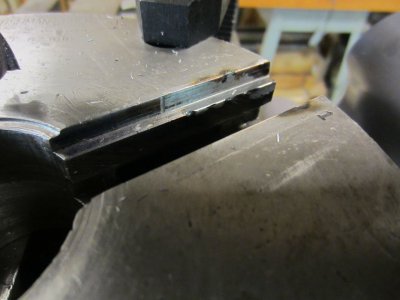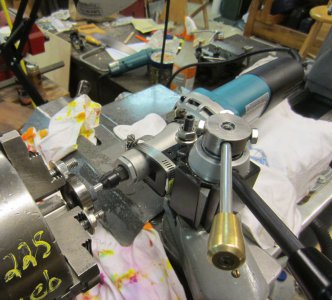- Joined
- Nov 18, 2013
- Messages
- 20
I recently got a 3 jaw 6" Cushman chuck for my SB9A off a used tool site. While it looked very nice and operated very well, once I had it on the lathe it had lots of runout (.010). Also lots of light between the jaws and the work near the jaw tips. On top of that it was not very repeatable. Not something I wanted to work with, and reselling junk on Fleabay is not my style. Not having much to loose, I decided to attempt repair.
Some disassembly, measuring & checking showed that there was wear in the jaw ways of the chuck body - the outboard 3/4" of the upper surface started to fall off and ended up .003 - .004 low. The bottom surface of the jaw ways seemed pretty consistent, though I had a hard time measuring that one. This was causing the jaws to rock as the chuck was clamped - just by using my hand, I was able to get .001-.0015 at the tip of the jaws. Scroll & everything else looked pretty good, though I didn't measure any of it (nor would I have a clue how to).
The chuck body was steel - so I got out my Mig welder and I built up the upper surface of the ways with a thin bead. I clamped the chuck body on the mill, indicated the side of the way parallel with the x-axis, and set the Z & Y to juuust scrape some bluing off the un-welded parts of the way. Then I milled the ways straight again with a nice new (sharp) 3/8 endmill.

After this possibly unorthodox procedure, the jaws actually fit without rocking. Still, there was a gap between clamped work and the tips of the jaws, and TIR was in the .004 range. I replaced one of the removable jaw bolts with some allthread, clamped an old bearing race in the allthread, used some hose clamps to attach a die grinder to the lathe toolpost, and ground the jaws straight. I used a crappy spirit line level on the chuck jaws to locate the jaws when rotating the chuck - worked surprisingly well.

End result is .002 or less TIR over a 1.5" to 0.5" clamping range (didn't have anything already round in a bigger size on hand), and no visible gaps along the jaw faces when work is clamped. Won't have industrial levels of durability, but for the occasional use when I need a chuck that size, it will probably last my lifetime. Also it was an interesting project, and didn't cost very much at all. And it turned 30lb of expensive scrap metal into a very nice chuck again.
I couldn't find much on low budget chuck restoration, so here is some encouragement if you find yourself with a crappy chuck and some spare time.


Some disassembly, measuring & checking showed that there was wear in the jaw ways of the chuck body - the outboard 3/4" of the upper surface started to fall off and ended up .003 - .004 low. The bottom surface of the jaw ways seemed pretty consistent, though I had a hard time measuring that one. This was causing the jaws to rock as the chuck was clamped - just by using my hand, I was able to get .001-.0015 at the tip of the jaws. Scroll & everything else looked pretty good, though I didn't measure any of it (nor would I have a clue how to).
The chuck body was steel - so I got out my Mig welder and I built up the upper surface of the ways with a thin bead. I clamped the chuck body on the mill, indicated the side of the way parallel with the x-axis, and set the Z & Y to juuust scrape some bluing off the un-welded parts of the way. Then I milled the ways straight again with a nice new (sharp) 3/8 endmill.

After this possibly unorthodox procedure, the jaws actually fit without rocking. Still, there was a gap between clamped work and the tips of the jaws, and TIR was in the .004 range. I replaced one of the removable jaw bolts with some allthread, clamped an old bearing race in the allthread, used some hose clamps to attach a die grinder to the lathe toolpost, and ground the jaws straight. I used a crappy spirit line level on the chuck jaws to locate the jaws when rotating the chuck - worked surprisingly well.

End result is .002 or less TIR over a 1.5" to 0.5" clamping range (didn't have anything already round in a bigger size on hand), and no visible gaps along the jaw faces when work is clamped. Won't have industrial levels of durability, but for the occasional use when I need a chuck that size, it will probably last my lifetime. Also it was an interesting project, and didn't cost very much at all. And it turned 30lb of expensive scrap metal into a very nice chuck again.
I couldn't find much on low budget chuck restoration, so here is some encouragement if you find yourself with a crappy chuck and some spare time.



